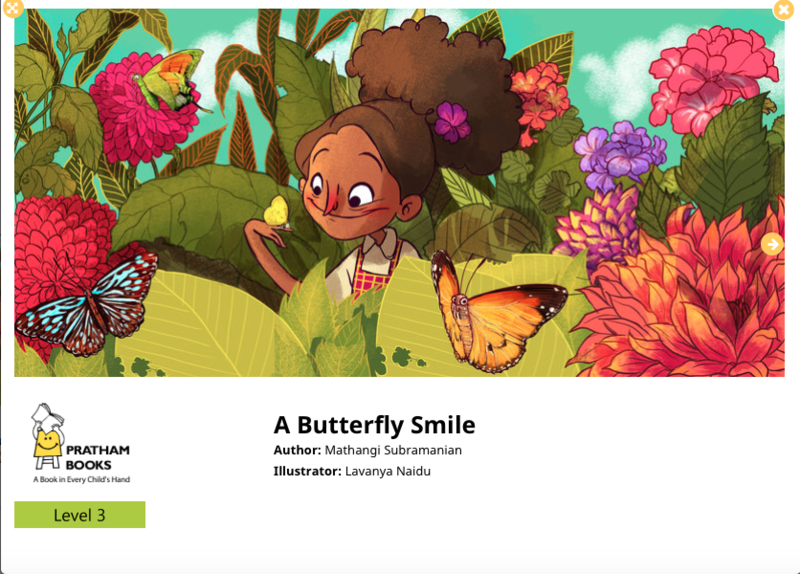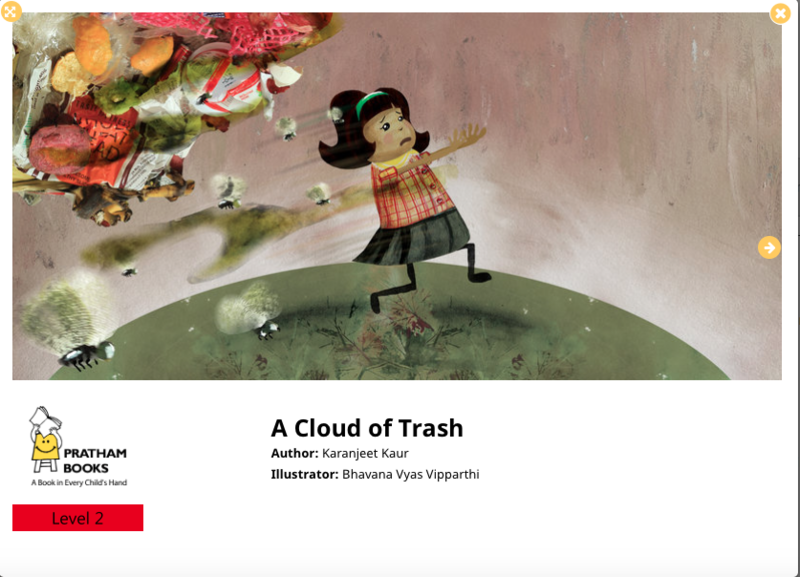Meet Team4Tech
Posted by Remya Padmadas on March 30, 2017The idea for Team4Tech was born in 2012, when Julie Clugage and Lila Ibrahim, witnessed the “transformative power of education”: Julie worked in a school in rural Guatemala while Lila worked in an orphanage in Lebanon. After working closely for years at Intel Corporation, to advance education and economic development through technology, they launched the Intel Education Service Corps in 2009. This program was met with incredible support as a large number of Intel employees began volunteering their time and expertise to the improvement of education.
In September 2012, they had another idea: creating a platform accessible to talented professionals from a variety of technological companies, to improve the quality of education around the world. With this in mind, in May 2013, they launched their first project in Kenya with a total of nine volunteers. The plan was to introduce an adaptive learning software solution to increase the education level of the primary school children. Within six months of this implementation, the students had doubled their literacy test scores. Since this project, Team4Tech has engaged in many similar projects, broadening their impact on education standards. One such project was run in November, 2016, in Hardoi, Uttar Pradesh by Dawn Kwan, the project manager for Team4Tech.
VMware and Udaan Mewat Teachers
She led a project with CARE India's Udaan Mewat school where a team of VMware employees brought technology to augment the teaching and learning objectives for a residential bridge-building school for girls, who had previously dropped out of school. Udaan Mewat is an innovative 11-month program where a group of 80 girls complete Grades 1 - 5 through innovative teaching methods, and continue their studies in government schools. After 5 weeks of preparation, the VMware volunteers spent a week in Mewat, showing the teachers how to use the technology provided - building long term sustainability of the equipment.
One of the tools used in this program was Pratham Books' StoryWeaver. Dawn taught three of CARE India’s master trainers, who work with government lower and upper primary school teachers (giving them a reach of over 1000 teachers and 50,000 students), how to use StoryWeaver. She reported that they “loved StoryWeaver's wealth of stories, the ability to translate and the ease of creating new stories.”
CARE India trainers learning about StoryWeaver
She also shared Varseena's story with us. A student in the first batch who had graduated from Udaan Mewat, Varseena learned how to use StoryWeaver. “She's extremely bright and created a story, and taught her story to the rest of the Udaan students”. Varseena will play a continuous role in the implementation of StoryWeaver since she was asked to teach the teachers how to use the platform. On the last day, one of the teachers even used a downloaded Pratham Books story in her class.
Team4Tech has clearly made a lot of progress in bettering the education system all over the world through their programs and outreach. The existence of platforms like StoryWeaver and KA Lite (an offline version of Khan Academy - also used by Team4Tech) makes this job easier and more fun for the students. The technological aspect of this is what excites people the most and, in a world where electronic devices have taken over lives, introducing education via technology engages the audience more than anything else. This is why, although few in number, organisations like Team4Tech are successful in completing their goals.
Be the first to comment.Wings: Mathangi Subramanian writes about migration, butterflies and brave, young girls
Posted by Remya Padmadas on March 23, 2017
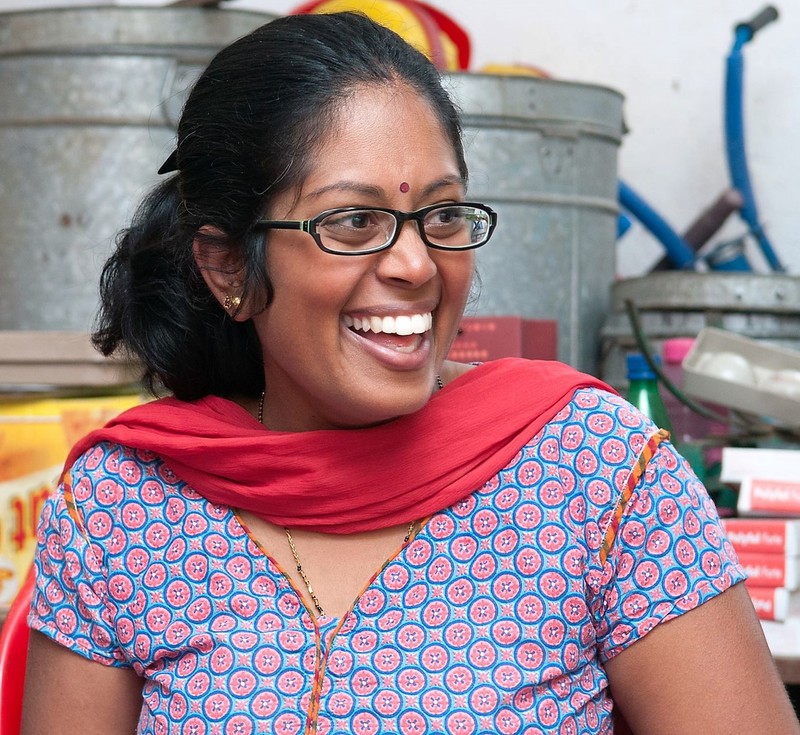
(Photo credit: Greshma Patel)
Mathangi Subramanian is an award winning author and educator who writes for the young and the young at heart. In 2016, her novel Dear Mrs. Naidu (Young Zubaan) won the 2016 South Asia Book Award and was shortlisted for the Hindu-Good Books prize. She currently lives in Delhi with her husband, her daughter, and many, many picture books. Her book 'A Butterfly Smile' is available to read, translate, download and share for free on StoryWeaver.
The thing I remember the most about the two years I lived in Bangalore is the construction. Everything was new, new, new: new flats, new hospitals and new offices. Every street seemed to have at least one cordoned off area where the air was thick with dust and the sidewalk was jagged and broken. People who grew up in Bangalore grumbled that the sleepy town they knew disappearing, brick by brick, block by block, swallowed up by glass walled skyscrapers sprouting from the pavement like steel flowers.
But I saw something different.
I didn’t just see new buildings. I saw new families. Mothers who buttoned men’s shirts over their saris, wrapped towels on their head to help balance buckets of rocks and gravel. Fathers who stopped to retie their dhotis before hoisting steel pans of gravel up to waiting hands cracked from sunlight and labour.
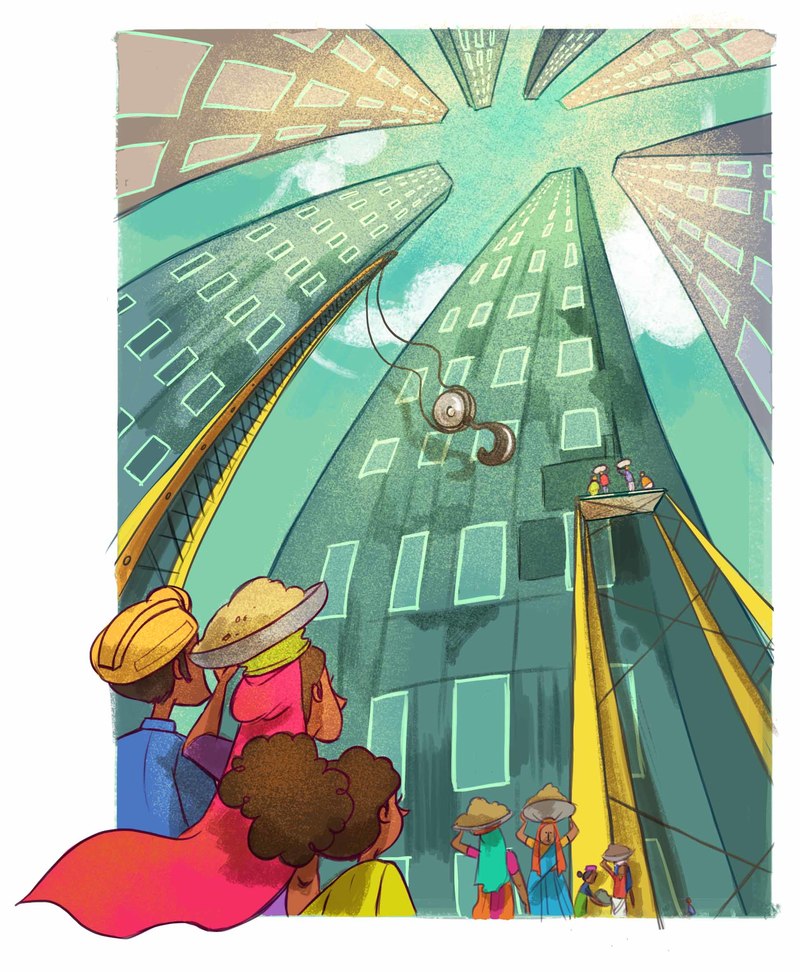
But most of all, I saw children. Babies playing in piles of sand, toddlers learning to walk on newly laid linoleum floors. Girls in faded school uniforms snapping laundry on lines strung between unfinished walls, boys eating roti off of dented metal plates in the shelter of unfinished doorways. Children who grow up shuttling between some of the city’s poshest buildings, and yet, were unsure of where their next meal is coming from.
Research repeatedly shows that in India, one of the primary reasons that parents migrate from villages to cities is for the schools. Some come from areas where education is subpar; others come from areas where there aren’t any schools at all.
Although children don’t have a say in their parents’ choices to migrate or stay, many that I’ve met over the years are thrilled at the chance to learn. But they are also terrified.
Remember your first day of school? You may have three, four, or five years old. Now imagine that first day as a seven, eight, or nine-year-old, sitting next to children who have already been learning to read and write and add and subtract for years before you even dreamed it was possible.
Kavya, the protagonist in “A Butterfly Smile,” is character I developed based on conversations I’ve had with migrant girls attending Bangalore schools where I once worked as a researcher. Like the girls I’ve met, Kavya is strong and hopeful and brave. But she is also grappling with moving to a city that labels her and her family as backwards, ignorant, and pitiful.
Just because Kavya has never gone to school, though, doesn’t mean she’s ignorant. Kavya, like many children, is observant and curious. She knows about butterflies because when she lived in her village, she paid attention to the world around her. She noticed life’s details.
In the city, we get used to tunneling our vision, to focusing only one what is in front of us so we can get through our day. So even though we see the traffic jam around a new construction that makes us late to work, we don’t see the butterflies hovering around our car windows, or the families building cooking fires in the shelter of a half-finished office building. We shut the bustle out just so we can get through our day.
For me, “A Butterfly Smile” is a story about migration. But it is also a story about the importance of looking around, and of seeing each other – insect and human, rich and poor, child and adult. Kavya is one of my favorite characters that I’ve created, because despite her uncertain world, she let has the courage to let life in.
After reading this story, I hope you will too.
You can read 'A Butterfly Smile' by Mathangi Subramanian and illustrated by Lavanya Naidu by clicking on the above image. The story has been translated to Tamil and French and will soon be available to read in Hindi, Marathi and Kannada.
Be the first to comment.Trash Talk with Bhavana Vipparthi
Posted by Remya Padmadas on March 13, 2017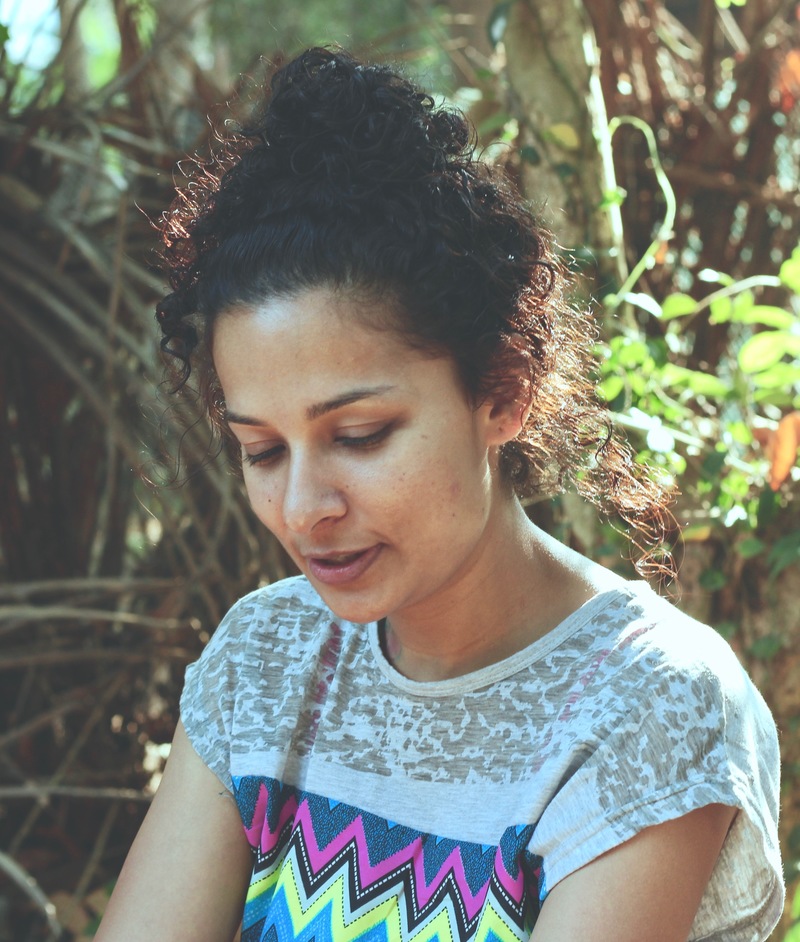
Bhavana Vyas Vipparthi, has lived and studied in Bangalore all her life. Having finished a Fine Arts course at Srishti, School of Art Design And Technology, she went on to do a masters in animation film design at NID in Ahmadabad. Her mind is now consumed by her terribly talkative two and a half year old son, a perfect dog, and a fellow animator husband. She makes up a million stories a day to stay sane. You can find their work on https://vimeo.com/
When I was given the opportunity to work on a book for Pratham Books, the script that got my attention was the one on garbage. Chikoo, a little litterbug gets a dose of her own messy medicine, when all the trash she keeps carelessly throwing around, comes back as a big cloud of smelly garbage that hangs over her head. Managing our garbage through very doable means like segregation and composting, has always been a cause I support. And I was very happy to get a chance to do my bit for this important issue. The script by Karanjeet Kaur was quirky and unusual. As I read it, I imagined a mixed media/ collage approach would work really well with the theme.

I knew straight away that the garbage had to be real. It would add a great texture to the images along with being the only effective way to show the reality of our very serious trash problem. I collected our trash at home over a few days, arranged it and photographed the cloud that would haunt Chikoo.
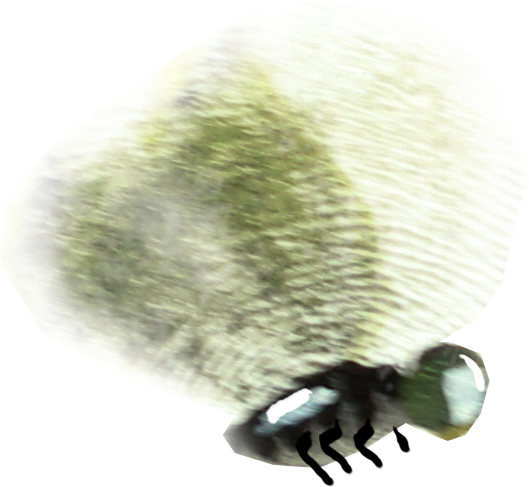
After the initial rough page layouts were done, I had a lot of fun exploring ways to show other elements. The flies that swarm around the cloud of trash were done with a dab of paint and fingerprints for their buzzing blurry wings.

The odorous vapours were cut out of OHP sheets and painted, as the paint dried on the plastic surface it left interesting organic patterns.
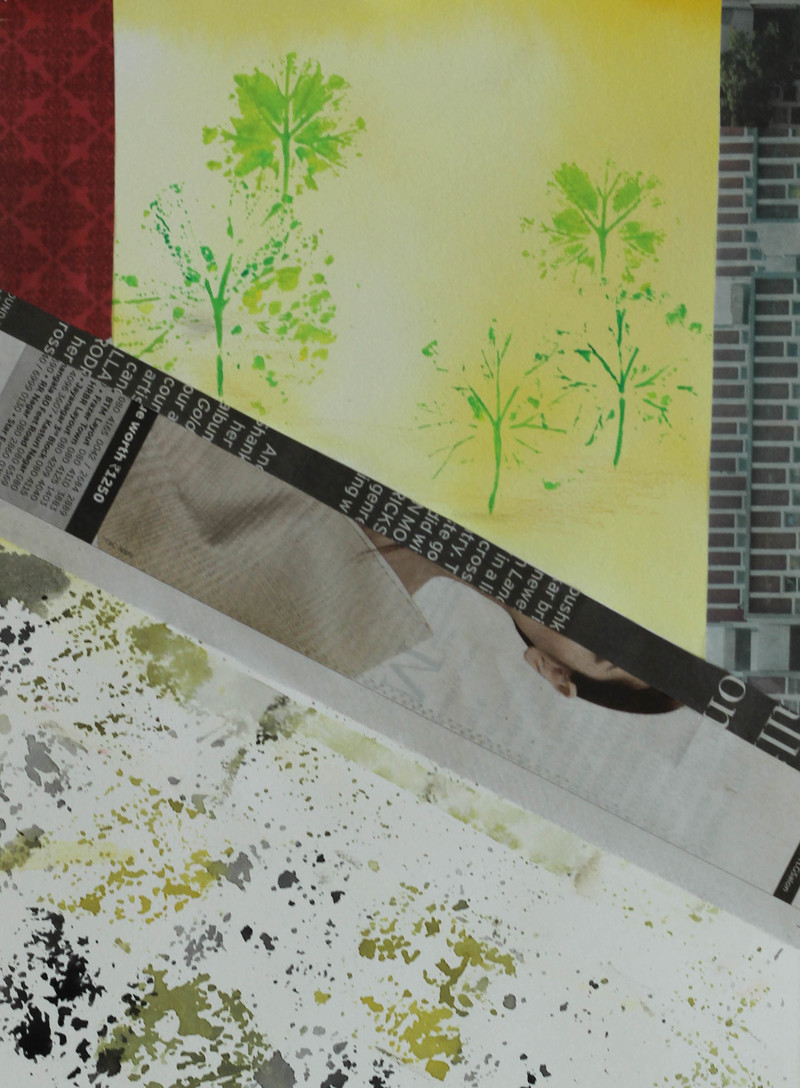

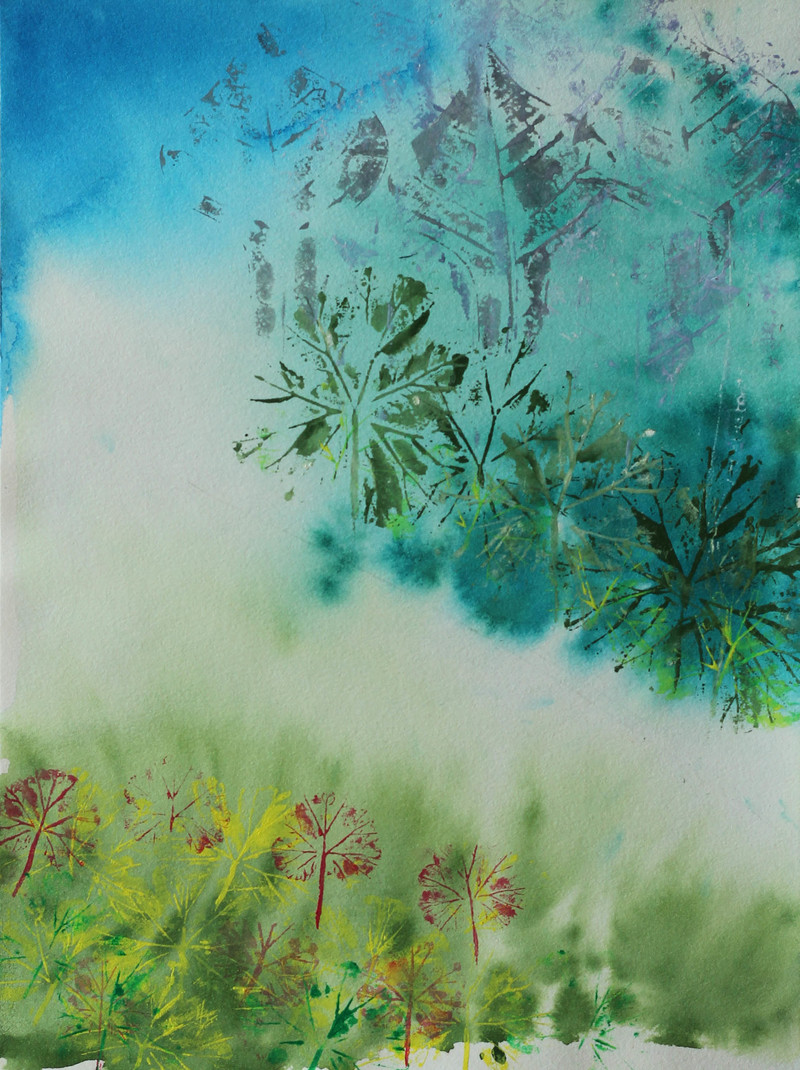
The backgrounds were done with watercolour and I used different kinds of leaves as stamps to make trees and bushes.
The ground and park railings were also created using different materials as stamps.

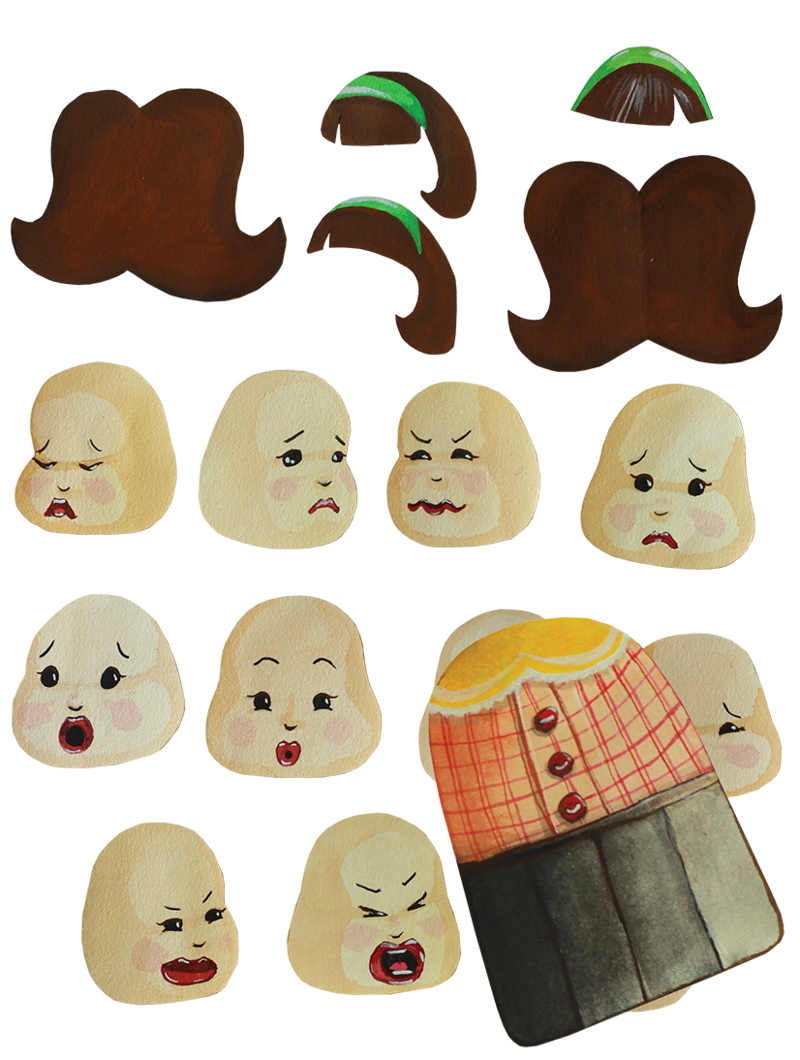
With this abundance of different textures, the characters had to stand out on the page, and making them cutouts solved this problem effectively. The final characters were drawn on paper, cutout, and carefully painted. They were made in different parts with the hair, head, and body as separate pieces. Legs and hands were drawn on the computer later. We always draw from our own influences and the uniforms are the very same ones that I wore as a quiet little girl in primary school.
All the different elements, backgrounds, desks, characters, flies, smell etc,were first photographed and then cleaned up on the computer. The final pages were assembled on Photoshop. Where most projects I work on start and end digitally, it was a welcome break to cut/paste/paint, explore and create something unique for this book.
You can read 'A Cloud of Trash' by Karanjeet Kaur and Bhavana Vipparthi by clicking on the image below
comment (1)
